
by Mark Smiley | Nov 19, 2021 | Travel
The Covid Grinch Could Steal Christmas As State Becomes Giant Covid-19 Mixing Bowl, Mountain Town Cases Soar; Flare-Ups In Denver Are Threatening Christmas Concerts
by Glen Richardson

Hospitalizations Skyrocket: Dr. Abbey Lara tends to patients in an ICU room at UCHealth as hospitalizations soar. She is pleading with people to do the “easy thing” and wear a mask and limit social gatherings.
As Cherry Creek Valley residents and families look to celebrate the holidays this month, Colorado has become a giant Covid-19 mixing bowl. Seeking a safe way to get festive, travelers and shoppers are shifting their sights away from mountain towns and downtown Denver to the Cherry Creek-Glendale neighborhoods. Nevertheless, fears are growing that the grouchy covid-19 creature is attempting to put an end to those holiday hopes.
At the beginning of November with Thanksgiving still weeks away, Colorado hospitals for the first time moved their transfer plan to the highest level during the pandemic. About one in every 51 Coloradans is now contagious with Covid-19 as the state registers the fifth-highest rate in the country with new infections compared to population.
With the pace of new coronavirus cases accelerating in Colorado, the state had asked the Federal Emergency Management Agency to send in medical teams to help in areas where hospitals are especially full. During the last two weeks of October the rate of new infections in Colorado accelerated rapidly. Only Alaska, Montana, North Dakota, and Wyoming have higher case rates compared to population.
County Countdown

Colorado Cases Spike: Daily Covid-19 cases in Colorado started ramping up in May and were soaring by early Sept. The Colorado Public Health & Environment chart was created by Evan Wyloge.
Most of the state’s large counties have seen increasing cases, though the trend line is especially steep in Pueblo County, which concerns state officials. “It’s probably not a coincidence that this is roughly the same time that Colorado saw rapidly increasing cases last year, though it’s not clear if that reflects changes in the weather itself or in human behavior,” they suggest.
If the current trajectory continues, the state should stay slightly below the peak set in December 2020, when 1,847 people were hospitalized with confirmed Covid-19, officials estimate.
Even if transmission goes down by 5% it’s still possible the state could exceed the previous peak, they warn. As the holiday nears, some heath officials are urging Gov. Jared Polis to issue a statewide indoor mask mandate.
Denver Cases Rising
Even more worrisome, the number of hospitalized covid patients and deaths in Denver County is also on the rise. An average of 274 cases per day were reported in Denver County as November got underway, a 47% increase from the average two weeks earlier.
Since the beginning of the pandemic, one in eight residents of the City & County of Denver has been infected, a total of 93,464 reported cases.

Events Altering Tune: Fans at this year’s Westword Music Showcase in September were greeted by reminder to show their Covid-19 vaccination status. Photo: CPR News
An article in the New York Times at the beginning of November suggested, “Denver County is at a very high-risk level of unvaccinated people because there was an average of 37 daily cases per 100,000 people reported in the past two weeks.” The risk in Denver County will decline from the high-risk level if the daily case rate drops to less than about 11.4 cases per 100,000 and the test positivity stays low, the paper suggested.
Christmas Events Impact

Holiday Crowd Concerns: With tens of thousands expected to attend holiday events such as the Dec. 14 Colorado Symphony Holiday Brass concert, check for new rules and regulations in advance.
In addition to the normal winter shows and concerts, dozens of Christmas events that were canceled last year are scheduled to return this month. They include several Nutcracker performances, A Charley Brown Christmas at Dazzle, and Colorado Symphony’s Holiday Brass at Boettcher Hall.
Covid flare-ups at metro-area concerts and events have been rare this year, with fewer than a half-dozen indoor events being canceled according the state’s Department of Health.
Nonetheless, promoters and artists are scrambling to impose sterner guidelines to slow down the virus and keep holiday concerts and shows on track. Upshot: If you and your family are among the tens of thousands planning to attend a holiday performance this month, check for new rules and regulations in advance.
Mountain Town Spike
People from all 50 states arriving in Colorado’s mountain towns to play this winter — plus vaccinated foreign travelers since Nov. 8 — are contributing to the high-country spike. Mountain activities where people gather without masks at restaurants-bars plus carpooling can lead to transmission. Many communities are seeing high enough Covid-19 transmission that authorities are putting restrictions on indoor dining, lodging, and gatherings. A surge of hospitalizations in Pitkin County — where Aspen is the county seat — has already resulted in a mask mandate order.
In addition to the influx of visitors, elevating factors include the winter weather, and because many essential employees live together in dense housing. Moreover, many of the visitors are coming from high pandemic states. Health officials have also found that when there is an increase in the number of mobile devices pinging in mountain towns, a rise in coronavirus cases follows seven to 10 days later.
Additionally, the pandemic is driving a migration of Americans to the state’s high-country communities. San Miguel County, for example, has seen a 20% increase in full-time residents. Plus, many people that own second-homes in the mountains are now starting to relocate to their mountain homes permanently.
Downtown Decline

Mountain Crowds: Even before the ski season began, crowds were flocking to Colorado’s mountain towns. Photos show crowds at September’s Jazz Aspen and at Little Nell’s gondola base. The hospitalization surge in Aspen has resulted in a mask mandate order for all of Pitkin County.
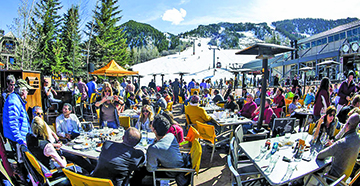 While mountain towns are booming, downtown Denver isn’t faring nearly as well. Denver’s downtown is currently seeing about 150,000 people walking around downtown compared to between 250,000 to 300,000 prior to the pandemic. According to the Downtown Denver Partnership, it’s hard to draw an apples-to-apples comparison because the data doesn’t go back to the summer of 2019. Nevertheless, it’s clear downtown foot traffic remains way down.
While mountain towns are booming, downtown Denver isn’t faring nearly as well. Denver’s downtown is currently seeing about 150,000 people walking around downtown compared to between 250,000 to 300,000 prior to the pandemic. According to the Downtown Denver Partnership, it’s hard to draw an apples-to-apples comparison because the data doesn’t go back to the summer of 2019. Nevertheless, it’s clear downtown foot traffic remains way down.
Remote work is a major reason for the drop downtown. Many companies still offer flexible work-from-home policies. Others are beginning to delay employee office return plans due to the renewed pandemic surge.
But pared down corporate travel to downtown Denver is also a major factor. Activities at the Denver Convention Center have picked up somewhat, yet remain far below where it was prior to the pandemic. Rich Carollo, director of sales and marketing at the Convention Center, reported few events in November.

by Regan Bervar | Nov 19, 2021 | Editorials
“There’s always an easy solution to every problem — neat, plausible and wrong.”
 by Luke Schmaltz
by Luke Schmaltz
Although camping in public areas has been “illegal” in the city of Denver since 2012, the homeless presence is expanding, tent cities are widespread, and the encampments are perpetuating crime, illegal drug use, and wholesale danger to everyone in the immediate vicinity.
A 2019 attempt to overturn the urban camping ban was unanimously voted down by 83%. Yet, while the sporadic sweep of encampments continues, often it is not until a deadly situation has arisen such as with the Morey Middle School encampment last year, and the encampment at 11th and Ogden on Capitol Hill, which was recently dismantled after a gun battle within the camp finally inspired action by the Denver Police Department.
In a June 30 public statement outside a women’s homeless shelter at 4600 East 48th Avenue, Denver Mayor Michael Hancock stated, “An episode of homelessness should be no more than a brief, one-time circumstance, and we must do everything in our power to stabilize our most vulnerable neighbors,” he said. “House keys have more power to change lives than a tent.” During this speech, the mayor also announced a new housing and homeless strategy — a five-prong plan which includes purchasing motels and hotels and turning them into supportive housing, extending housing voucher programs, adding more sanctioned camping sites, increasing the availability of housing, and adding more eviction protection and rental assistance.
Multiple Culprits

Homeless In Neighborhoods: It is widely known that anyone can camp out on the streets of Denver without legal consequences.
The City of Denver is allocating more funds than ever before to deal with the homeless crisis; the solutions, however, seem to be missing the mark. Although there is some truth to the observation that homelessness is caused by an inability to afford a place to live, it is far likelier that the situation is the result of a more complex combination of circumstances.
If housing was the sole issue, then the myriad sanctioned shelters offering beds, showers and meals would be — at the very least — having somewhat of an impact on the growing problem. Yet, contrary to the expected result, the solution at hand seems to be having a reverse effect. Perhaps it is not working because it is not accurately addressing the problem. The current policy is akin to a Band-Aid on an ax wound, a cup of water on a forest fire, a moldy biscuit into the hand of a starving person in a country with no shortage of food.
You Don’t Say
Once it is accepted that the causes of homelessness run deeper than a simple lack of places to live, the discussion can continue. Among the many possibilities are four standouts which deserve consideration: Drug addiction, the lack of healthcare for the mentally ill, an experimental (and failing) approach to law enforcement policy, and a populace that is vastly divided on the imminent threat and what it means to self-police.
Just Take Two
The prescription drug boom of the early-to-mid 2010s created millions of addicts as doctors, using the tried and true “misdiagnose and overprescribe” approach, made handsome amounts of money in kickbacks from pharmaceutical companies. Finally, under intense pressure from the DEA and the public at large, the FDA began imposing tighter regulations in 2014. In the case of the near 50 million patients who were prescribed opioids in 2013 alone, this created a growing tide of addicted users of painkillers such as Demerol, Vicodin, and Oxycontin.
A June 2021 report published by drug abuse.gov cites extensive studies which link heroin use to prescription pills and their increasing unavailability. The report explains, “… almost half of all opioid deaths in the U.S. now involve a prescription opioid … Research now suggests that misuse of these medications may actually open the door to heroin use. Some also report switching to heroin because it is cheaper and easier to obtain than prescription opioids.” Someone addicted to opioids who turns to street drugs may not have both feet in the gutter, but they have definitely begun to step off thanks to the medical/pharmaceutical industrial complex.
It’s All In Your Head
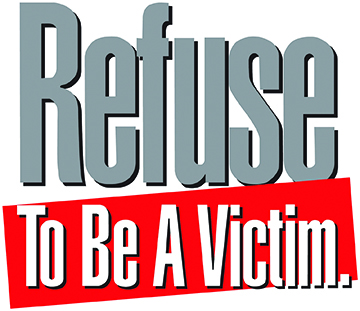
Refuse To Be A Victim: Most people living near an illegal encampment do not understand the level of potential danger they are in.
The saying “homelessness causes addiction and addiction causes homelessness” gets thrown around a lot in discussions like this, and the term “mental illness” can be substituted for “addiction” with great accuracy. It has long been acknowledged that mental instability is an underlying contributor.
In fact, a report published in July 2009, by the National Coalition for the Homeless states, “Serious mental illnesses disrupt people’s ability to carry out essential aspects of daily life, such as self-care and household management. Mental illnesses may also prevent people from forming and maintaining stable relationships or cause people to misinterpret others’ guidance and react irrationally. This often results in pushing away caregivers, family, and friends who may be the force keeping that person from becoming homeless. As a result of these factors and the stresses of living with a mental disorder, people with mental illnesses are much more likely to become homeless than the general population (Library Index, 2009). A study of people with serious mental illnesses seen by California’s public mental health system found that 15% were homeless at least once in a one-year period (Folsom et al., 2005). Patients with schizophrenia or bipolar disorder are particularly vulnerable.” Yet, nowhere in Mayor Hancock’s five-prong plan to address homelessness is there mention of mental health services.
Police Paralysis
 Intense public pressure and widespread scrutiny after the 2020 Downtown protests have forced Denver police officers and those in surrounding districts to adopt a hands-off approach to fighting crime. Police departments are having to operate in a fire department-type capacity where they respond only if a citizen calls rather than use proactive tactics such as patrol, stop, search, etc., to reduce crime. This policy has placed normally actionable crimes such as drug dealing, drug using, assault, theft, and public evacuation of one’s bodily wastes on “low priority” — sending a signal to campers that there is a new era of lawlessness afoot, it’s a free-for-all drug party and there are no consequences for committing many types of crimes.
Intense public pressure and widespread scrutiny after the 2020 Downtown protests have forced Denver police officers and those in surrounding districts to adopt a hands-off approach to fighting crime. Police departments are having to operate in a fire department-type capacity where they respond only if a citizen calls rather than use proactive tactics such as patrol, stop, search, etc., to reduce crime. This policy has placed normally actionable crimes such as drug dealing, drug using, assault, theft, and public evacuation of one’s bodily wastes on “low priority” — sending a signal to campers that there is a new era of lawlessness afoot, it’s a free-for-all drug party and there are no consequences for committing many types of crimes.
What’s more, a new group of policy influencers are at work known as The Denver Task Force to Reimagine Policing and Public Safety. This group is comprised of activists and youth ministry leaders as well as individuals from civil rights, faith-based, policy advocacy, and youth services organizations. They have put together a 53-page report of a total of 112 recommendations on how the police at large can better serve the communities in which they work. Strangely, not one of the 140+ members is a police officer or has any experience whatsoever in the business of fighting crime.
Their recommendations were recently submitted to Denver City Council, who will review and determine the next course of action. Movements such as this reinforce the message to the criminal element that more bureaucratic red tape is on the horizon, police will have to continue to “look the other way,” and the consequence-free camping, drugging, stealing, and raping party can continue indefinitely.
It Takes A Village

Opioid Addiction: A prescription for painkillers can lead to opioid addiction, to illegal drugs, and then to living on the street.
It is unfair and inaccurate to label someone as a criminal because they are homeless. As stated above, they could be suffering from addiction, mental illness, or economic hardship which resulted in them not having a place to live. Yet, it is downright ignorant and just plain stupid to think that homeless encampments do not contain a criminal element. As anyone who has had a camp pop up on their block can attest — theft, harassment, assault, muggings, and the widespread presence of hypodermic needles all increase in the area exponentially.
Yet, citizens are divided on taking a unified stance that these phenomena are bad for the neighborhood, and some go so far as to verbally attack their housed neighbors who are not in favor of the denigration of the community. What’s more, without an overt police presence, citizens must protect themselves from predators and the sad fact is that most people do not know how to fight, or even the basics of self-defense. The lack of a unified community mindset and the clear signs that most people cannot defend themselves send yet another signal to people living in illegal camps that it is ok to do as they please because nobody on the block is willing or able to do anything about it.
So, as you drive past the camps in your city, in your neighborhood and on your block and wonder why it is happening, you may want to look past the obvious conclusion of economic hardship and take a further glimpse into causal factors. Instead of blaming the homeless, blame the doctors and pharmaceutical companies, blame inherent human craziness, blame the bureaucrats, and yeah — blame yourself.

by Mark Smiley | Nov 19, 2021 | Feature Story Bottom Left

Karl Honegger
by Karl Honegger
I recently paid $120 to fill up my SUV, bringing back memories of 2012 when I was a college student working two jobs to support my wife and newborn. It was difficult to balance the cost of rent, diapers, food, and gas. It felt like I’d been punched in the gut every time I left the gas station. Because I have a nine-year career under my belt, a master’s degree, and a professional certification, my income is higher. While it doesn’t hurt as much when I fill up my gas tank, I’m still reminded of how much the price of gas impacted my life. It still impacts me because my wife and I drive a full-size passenger van because of my eight-person family.
It is important to understand that it was a strange convergence of events that caused the price of gas to be so low the last decade. Why we used to enjoy low gas prices is because of three factors:

Senator Kevin Priola
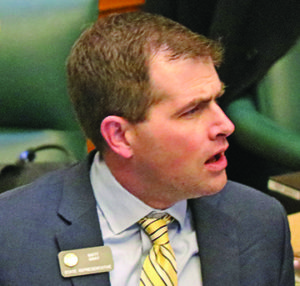
Representative Matt Gray
The first is that the United States is one of the few countries where individuals are allowed to own the minerals in the ground. They can then sign contracts with oil and gas companies to drill and sell those minerals. This free market causes oil companies to be fiercely competitive. March of 2011, NATO commenced a seven-month bombing campaign in Libya and the country was tossed into a brutal civil war. This took almost 1,500 barrels per day of oil off the international market and helped support the price of crude oil for the next few years. Here is how this impacted the United States — oil producers decided that they were going to invest billions in exploring and developing shale oil fields where the cost of drilling for a barrel of oil is much higher. The scientists and petroleum engineers working for those companies then figured out ways to drive down the cost of drilling for shale oil. The United States ended up producing a higher percentage of the world’s supply of oil. This innovation was great for the United States but gave Saudi Arabia a headache.
This brings us to the second factor, Saudi Arabia and OPEC decided they would stop working so hard to prop up the price of crude oil by constantly cutting their own production. Instead, they would flood the market. From mid-2014 to early 2016 the price of crude oil dropped 70% as Saudi Arabia entered a risky battle with US Shale oil companies for market share. The Saudi’s won. This led to over 100 oil and gas companies declaring bankruptcy in 2020, including Whiting Oil and Gas which I used to work for. The bright side was that this oil war was saving American’s $180 billion a year.
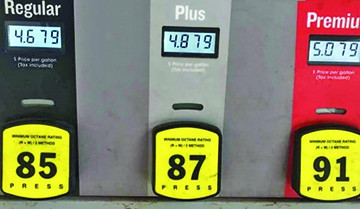 The third factor that led to the low oil prices was that the world enjoyed some peace during the previous administration. The oil production of Libya came back on-line, and we managed to stay out of war with Iran. The combination of these three synergistic factors led to the low gas prices we used to enjoy. Those times will never return. Saudi Arabia is willing to keep oil prices high after winning their price war and demand for oil has recovered after last year’s government lockdowns. The cost of transporting our food to the grocery store, or driving to visit friends and family, or driving to work will remain expensive.
The third factor that led to the low oil prices was that the world enjoyed some peace during the previous administration. The oil production of Libya came back on-line, and we managed to stay out of war with Iran. The combination of these three synergistic factors led to the low gas prices we used to enjoy. Those times will never return. Saudi Arabia is willing to keep oil prices high after winning their price war and demand for oil has recovered after last year’s government lockdowns. The cost of transporting our food to the grocery store, or driving to visit friends and family, or driving to work will remain expensive.
With this in mind, we must fight any new tax disguised as a fee on gas or transportation. The poor and middle class do not need to pay more at the pump as housing prices and out of control inflation continue to squeeze their budgets tighter and tighter.
The corporatists at Colorado Concern demonstrate how out of touch they are by giving Senator Kevin Priola their “In the Arena” award for his support of Senate Bill 260. This bill, sponsored in the State House by my Representative Matt Gray, creates an additional “fee” per gallon of gas. But the money doesn’t go to just roads, it’s also designed to funnel your money towards electrical vehicle “infrastructure” and to subsidize governments buying electric vehicles. Colorado Concern’s award is for the legislator whose “face is marred by dust and sweat and blood; who strives valiantly… who spends himself in a worthy cause…” If politicians like Priola did have any guts, they would have taken this bill to the voters as required by the Taxpayer Bill of Rights. Rather they chose the easy way out by calling a tax a “fee.” This form of sniveling cowardice is what big business interests at Colorado Concern want more of. Next time you are at the gas pump, give State Senator Priola or Representative Gray a call and let them know you don’t appreciate their “fee” on the gas you need to live your life. Colorado Concern may be funded by wealthy cronies who want politicians to do their bidding, but it’s time the voters let them know we’ve had enough.
Karl Honegger is on the Steamboat Institute’s Emerging Leaders Council and a board member of the Colorado Union of Taxpayers. He is a Certified Treasury Professional and works for a “tech-enabled” healthcare company as a Financial Reporting Accountant.

by Charles Bonniwell | Nov 19, 2021 | Main Articles
Developer Still Seeks Commercialization With Help Of Hancock Administration
by Charles Bonniwell

From Above: An aerial view of the entire 155-acre Park Hill Golf Course area under threat of commercialization from developer Westside Investment Partners and the Hancock Administration.
The voters appeared to overwhelmingly state that they wanted the 155-acre Park Hill Golf Course area to remain green space. By an almost 2-to-1 margin, voters approved Initiated Ordinance 301 which required citywide voter approval to build on the land. The initiative and the campaign were headed up by former mayoral candidate Penfield Tate III, who headed up Save Open Space Denver (“SOS Denver”), and former Denver mayor and Park Hill resident Wellington Webb. The slogan of the campaign was “Green over Concrete.”
Tate indicated that the message hit home for residents who have seen massive new density across Denver, supported with the direct and indirect support of Denver Mayor Michael Hancock. The developer, Westside Investment Partners (“Westside”) bought the property in 2019 for $24 million from Clayton Early Learning. Westside put up its own Initiative 302 which was almost exactly the same as 301 but exempted golf courses from the definition of a conservative easement. The net effect of 301 and 302 passing would allow the developer to proceed with development of Park Hill, notwithstanding the passage of 301. Tate indicated that he was pleased that the voters were not fooled by Westside’s tricky, similar sounding Initiative.
Visioning Process
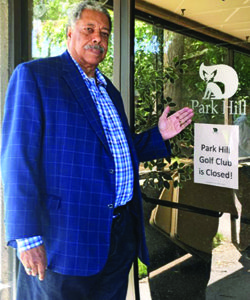
Still Leading: Former Denver mayor Wellington Webb, a Park Hill resident, has help to lead the fight to stop the commercialization of the Park Hill Golf Course area.

Still Under Threat: Notwithstanding an overwhelming 2-to-1 vote in Ballot Initiative 301 and 302 to require a city-wide vote before lifting a conservation easement on the 155 acre Park Hill Golf Course, developer Westside Investment Partners with the strong backing of the Hancock Administration and taxpayer dollars is moving full steam ahead to try to commercialize the green space.
The battle continues with Hancock and Westside trying to figure out how to outmaneuver Webb and Tate and the citizens who want more and not less open space. Some say the Hancock Administration has gone to extraordinary lengths to help Westside. In what critics contend was a contrived lawsuit, Westside sued the city over a drainage easement on the land. In settlement, the city provided an enormous war chest of $6 million for Westside to fight citizen groups like SOS Denver. That agreement gives Westside a three-year window for a public engagement process (i.e., a public relations campaign).
The city set up an expensive Denver taxpayer funded “Park Hill Golf Course Area Visioning Process” which basically plans the commercial development on behalf of Westside with a 27-member Park Hill Steering Committee. It appears that the Steering Committee is largely composed of apparently pro-development members.
Another Lawsuit
SOS Denver’s response was to file a lawsuit against Mayor Hancock and the City and County of Denver in June 2021 that alleges the public planning process is illegal until the conservation easement is lifted.
“The city has to follow the law. That’s the whole point of our lawsuit,” declared Tate. He stated the entire public engagement process was a sham and a waste of taxpayer dollars. The city issued a statement that the Park Hill planning process was a very standard one and that gathering community input for future use did not in any way interfere with the conservation easement.

The Good, The Bad, And The Ugly: Attorney and former mayoral candidate Penfield Tate Hill III, below, headed up Save Open Space Denver and helped win Ballot Initiative 301 and defeat Ballot Initiative 302 proposed by Westside Investment Partners (“Westside”) whose public face is Kenneth Ho, above. Ho was supported by Park Hill Steering Committee member Pastor Del Phillips, right, who claimed green open space in Park Hill is somehow racist and who is considered by his critics to be little more than a shill for Westside.
Holleran Group’s (Westside’s partner) CEO & Managing Partner Norman Harris indicated that it was not slowing down due to the overwhelming vote of Denver’s citizens. With a massive fortune to be made if the conservation easement on Park Hill can be eliminated, Holleran proclaimed it to be a visioning process, in a story published by The Denverite:
“We are going to double down on our community outreach to assure that we are bringing the right folks to the table and truly achieve an equitable outcome,” Harris said. “We’re very confident that we are going to be successful, and we just really look forward to the opportunity to bring more people into the conversation.”
Park Hill Steering Committee head Pastor Del Phillips indicated that preventing the commercial development was racist in nature given the history of Park Hill. He stated at a rally in October:
“I think it is highly unusual how people say this is about saving green space… This is really about people who believe they have the right to choose where other folks want to live.”
Kenneth Ho of Westside did not see the 2-to-1 vote against its initiative as a loss for the commercial development of Park Hill but rather: “We understand that residents want to hear more details about what this can be.” He went on to declare: “I think what the initiative does is it now says we need to come up with a plan for the voters to vote on. I think the next step is to develop that and put some specifics around the plan.”
What’s Next

Pastor Del Phillips
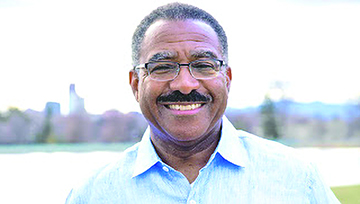
Penfield Tate Hill III
The Steering Committee is expected to provide the city its recommendations by Thanksgiving in the form of a Vision Summary which is expected to be very pro developer and little more than a glossed over version of what Westside wants. It will be used to give pro developer recommendations to the Denver City Council by the Community Planning and Development department which is controlled by the Hancock Administration.
SOS Denver indicates it is ready for the fight first at the City Council level and if that fails on a second ballot measure now required by Initiative 301 to lift the conservation easement.
Wellington Webb declared: “For me, what’s next is to get reengaged with my Nuggets tickets. Then we go back and look at what are the areas for reconciliation to some degree.”






 While mountain towns are booming, downtown Denver isn’t faring nearly as well. Denver’s downtown is currently seeing about 150,000 people walking around downtown compared to between 250,000 to 300,000 prior to the pandemic. According to the Downtown Denver Partnership, it’s hard to draw an apples-to-apples comparison because the data doesn’t go back to the summer of 2019. Nevertheless, it’s clear downtown foot traffic remains way down.
While mountain towns are booming, downtown Denver isn’t faring nearly as well. Denver’s downtown is currently seeing about 150,000 people walking around downtown compared to between 250,000 to 300,000 prior to the pandemic. According to the Downtown Denver Partnership, it’s hard to draw an apples-to-apples comparison because the data doesn’t go back to the summer of 2019. Nevertheless, it’s clear downtown foot traffic remains way down.















